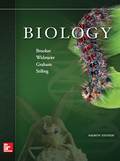
Concept explainers
Introduction: Hemolymph is the mixed fluid present in animals like Arthropods and Molluscs. It is an important constituent of their unique open circulatory system. The hemolymph helps to exchange the nutrients and the waste products from the body.
Answer to Problem 1TY
Correct answer: The hemolymph is the fluid that circulates in the body cavity of the animals like Arthropods and Molluscs. This cavity is called hemocoel. Hence, the correct answer is option b.
Explanation of Solution
Reason for correct answer:
The hemolymph enters the blood vessels in the Molluscs, while in Arthropods it directly enters the heart of the organism.
Option b. is given as, “is a mixture of fluid in blood vessels and the hemocoel”.
Hemolymph is the fluid present in the cavity called the hemocoel in Arthropods. In Molluscs, it enters the heart through blood vessels. Hence, the correct answer is option b.
Reasons for the incorrect answer:
Option a. is given as, “does not contain blood cells”.
Hemolymph is the fluid that contains the blood cells. It is required to transport nutrients and waste materials in the body of an animal. Hence, option a. is incorrect.
Option c. is given as, “circulates through closed circulatory systems only”.
The hemolymph is a feature of the open circulatory system present in the Arthropods and Molluscs. Hence, option c. is incorrect.
Option d. is given as, “functions only in defense of the body and not transport”.
Hemolymph is used to transport waste material to the excretory organs and nutrients to the rest of the body. Hence, option d. is incorrect.
Option e. is given as, “does not pass through a heart”.
The hemolymph enters the heart directly in Arthropods, and through blood vessels in Molluscs. Hence, option e. is incorrect.
Hence, the options a., c., d., and e. are incorrect.
The Arthropods and the Molluscs have a unique feature of an open circulatory system where the hemolymph is present freely in the hemocoel (body cavity) and is not confined to unique vessels.
Want to see more full solutions like this?
Chapter 47 Solutions
EBK BIOLOGY
- Which of the following is not a DNA binding protein? 1. the lac repressor protein 2. the catabolite activated protein 3. the trp repressor protein 4. the flowering locus C protein 5. the flowering locus D protein 6. GAL4 7. all of the above are DNA binding proteinsarrow_forwardWhat symbolic and cultural behaviors are evident in the archaeological record and associated with Neandertals and anatomically modern humans in Europe beginning around 35,000 yBP (during the Upper Paleolithic)?arrow_forwardDescribe three cranial and postcranial features of Neanderthals skeletons that are likely adaptation to the cold climates of Upper Pleistocene Europe and explain how they are adaptations to a cold climate.arrow_forward
- Biology Questionarrow_forward✓ Details Draw a protein that is embedded in a membrane (a transmembrane protein), label the lipid bilayer and the protein. Identify the areas of the lipid bilayer that are hydrophobic and hydrophilic. Draw a membrane with two transporters: a proton pump transporter that uses ATP to generate a proton gradient, and a second transporter that moves glucose by secondary active transport (cartoon-like is ok). It will be important to show protons moving in the correct direction, and that the transporter that is powered by secondary active transport is logically related to the proton pump.arrow_forwarddrawing chemical structure of ATP. please draw in and label whats asked. Thank you.arrow_forward
- Outline the negative feedback loop that allows us to maintain a healthy water concentration in our blood. You may use diagram if you wisharrow_forwardGive examples of fat soluble and non-fat soluble hormonesarrow_forwardJust click view full document and register so you can see the whole document. how do i access this. following from the previous question; https://www.bartleby.com/questions-and-answers/hi-hi-with-this-unit-assessment-psy4406-tp4-report-assessment-material-case-stydu-ms-alecia-moore.-o/5e09906a-5101-4297-a8f7-49449b0bb5a7. on Google this image comes up and i have signed/ payed for the service and unable to access the full document. are you able to copy and past to this response. please see the screenshot from google page. unfortunality its not allowing me attch the image can you please show me the mathmetic calculation/ workout for the reult sectionarrow_forward
 Human Anatomy & Physiology (11th Edition)BiologyISBN:9780134580999Author:Elaine N. Marieb, Katja N. HoehnPublisher:PEARSON
Human Anatomy & Physiology (11th Edition)BiologyISBN:9780134580999Author:Elaine N. Marieb, Katja N. HoehnPublisher:PEARSON Biology 2eBiologyISBN:9781947172517Author:Matthew Douglas, Jung Choi, Mary Ann ClarkPublisher:OpenStax
Biology 2eBiologyISBN:9781947172517Author:Matthew Douglas, Jung Choi, Mary Ann ClarkPublisher:OpenStax Anatomy & PhysiologyBiologyISBN:9781259398629Author:McKinley, Michael P., O'loughlin, Valerie Dean, Bidle, Theresa StouterPublisher:Mcgraw Hill Education,
Anatomy & PhysiologyBiologyISBN:9781259398629Author:McKinley, Michael P., O'loughlin, Valerie Dean, Bidle, Theresa StouterPublisher:Mcgraw Hill Education, Molecular Biology of the Cell (Sixth Edition)BiologyISBN:9780815344322Author:Bruce Alberts, Alexander D. Johnson, Julian Lewis, David Morgan, Martin Raff, Keith Roberts, Peter WalterPublisher:W. W. Norton & Company
Molecular Biology of the Cell (Sixth Edition)BiologyISBN:9780815344322Author:Bruce Alberts, Alexander D. Johnson, Julian Lewis, David Morgan, Martin Raff, Keith Roberts, Peter WalterPublisher:W. W. Norton & Company Laboratory Manual For Human Anatomy & PhysiologyBiologyISBN:9781260159363Author:Martin, Terry R., Prentice-craver, CynthiaPublisher:McGraw-Hill Publishing Co.
Laboratory Manual For Human Anatomy & PhysiologyBiologyISBN:9781260159363Author:Martin, Terry R., Prentice-craver, CynthiaPublisher:McGraw-Hill Publishing Co. Inquiry Into Life (16th Edition)BiologyISBN:9781260231700Author:Sylvia S. Mader, Michael WindelspechtPublisher:McGraw Hill Education
Inquiry Into Life (16th Edition)BiologyISBN:9781260231700Author:Sylvia S. Mader, Michael WindelspechtPublisher:McGraw Hill Education





